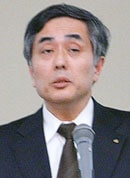[ Financial Results for Fiscal 2011 Performance Briefing ]Passive Components Business
Mr. Shinichi Araya
Director
Senior Vice President
My presentation concerns the passive components business. In the fiscal year ended March 31, 2011, the passive components segment recorded net sales of ¥431.1 billion, an 18.2% increase from ¥364.8 billion in the previous fiscal year. All businesses that make up this segment?capacitors, inductive devices, and other passive components?posted higher sales. The segment also returned to profitability, posting operating income of ¥24.7 billion, after recording a ¥10.3 billion operating loss in fiscal 2010. Looking at each component business separately, the capacitors business recorded net sales of ¥145.4 billion, 9.2% more than the ¥133.1 billion it posted in fiscal 2010. Ceramic capacitor sales declined for use in AV equipment and other home information appliances. However, healthy sales growth was recorded for use in mobile phones and other communications equipment, and automobiles. In the current fiscal year ending March 2012, we plan to launch new products, at the same time as expanding back-end processing in China. Our cost competitiveness should be better thanks to the new processes we began adopting in the fourth quarter of the fiscal year ended March 2011. Aluminum electrolytic capacitors and film capacitors, recorded sharply higher sales for use in industrial equipment and renewable energy equipment. We plan to expand business in this area by making investments to ramp up production so that we can meet buoyant demand.
The inductive devices business recorded net sales of ¥135.8 billion, 21.3% more than the ¥112.0 billion in fiscal 2010. Sales jumped for use in communications equipment, especially smartphones. And healthy sales growth was also seen in noise filters for automobiles and industrial equipment. Besides optimizing production capabilities in order to respond to expanding demand over the medium and long terms, we will aggressively bring competitive new products to market.
Finally, in other passive components, we recorded net sales of ¥150.0 billion. This was 25.2% more than the ¥139.7 billion recorded in fiscal 2010. The principal reason was sharply higher sales of high-frequency components for smartphones, mobile phones and other communications equipment stemming from synergies with EPCOS following our acquisition of this company. Looking ahead, we will strive to expand business by launching new products for smart phones and 3G terminals. These markets are expected to grow going forward.
Passive Components Business Sales by Application
Now let me look at how sales trended by application field in the passive components business. Earlier, President Kamigama discussed sales by field for the whole company. Well, sales by market in this business mirrored companywide sales. We are concentrating on three growth fields: communications, car electronics, and other, which includes industrial equipment and renewable energy. Sales grew significantly in all these growth fields. Naturally, sales are influenced by market trends for finished products. But the EPCOS acquisition has produced noticeable benefits. On example is considerable expansion in the high-frequency module business targeting smartphones and 3G terminals.
Passive Components Business Sales by Application
This slide shows the change in sales composition by application in the passive components business. Due to the higher sales in growth fields that I explained on the previous slide, communications, car electronics, and other, including industrial equipment, collectively grew to account for 82% of net sales in fiscal 2011; they accounted for 69% in fiscal 2009. We hope to expand business further by bringing even more new products to these growth markets as we go forward.
Thank you for you attention.


